Top Communist Party officials emphasize ‘Sinicization’ of Buddhism while the China-appointed Panchen Lama visits lake associated with search for the Dalai Lama’s reincarnation
China has tightened the screws on Tibetan Buddhism, with one of China’s top leaders emphasizing increased Communist Party control over the religion a few days after the China-appointed Panchen Lama prayed at a sacred lake associated with the search for the Dalai Lama’s reincarnation.
- Wang Yang, the fourth highest ranking official in the Politburo hierarchy and head of the Chinese People’s Political Consultative Conference (CPPCC), stressed the importance of tighter controls over religion and the new official goal of ‘Sinicizing’—or bringing under Chinese control—Tibetan Buddhism during an ‘inspection tour’ of the Tibetan cities of Lhasa and Chamdo on August 24-26.
- After a period of keeping a low profile, the Chinese-appointed Panchen Lama has become more outspoken in support of Party policy. Recently he made a symbolic visit to the sacred ‘oracle’ lake of Lhamo Latso, which attracts many Tibetan pilgrims and is famous for giving them visions, including of reincarnations. After the passing away of the 13th Dalai Lama, the then-Regent of Tibet saw a vision in the lake that led him to the home of the present Dalai Lama.
- At a meeting of Party-run religious institutes, calls were made for a new database that would consolidate control over monks, influence a new generation of monastics and track those loyal to the Dalai Lama. The calls follow the creation of a controversial database that seeks to ensure that Buddhists do not reincarnate without Chinese government permission.
- Coinciding with a campaign to increase Communist Party membership in Tibet, a new set of regulations issued by Chinese authorities penalize Party members who follow a religion.
Top Party leaders visit Tibet, assert tightening control
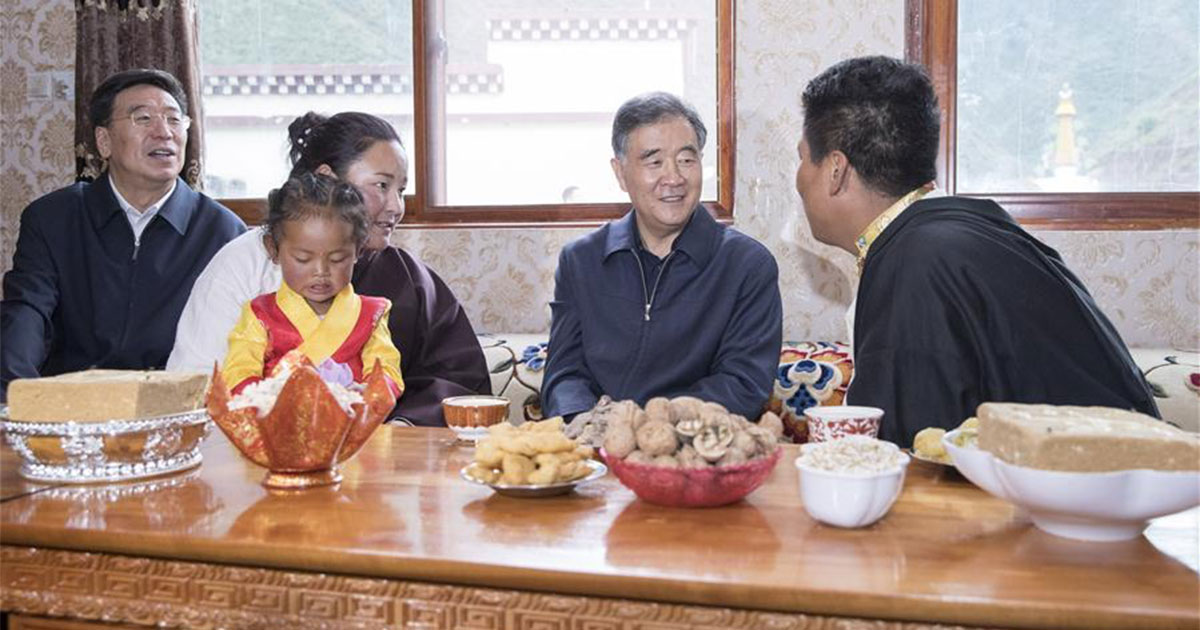
This image from the Chinese state media shows top political advisor Wang Yang visiting a Tibetan family in Chamdo (Chinese: Qamdo), the Tibet Autonomous Region. During his visit, Wang Yang emphasised tightening controls over Buddhist religion.
Wang Yang, a member of the Standing Committee of the Chinese Communist Party Politburo, emphasized the importance of tightening control over religion during an August visit to the Tibet Autonomous Region (TAR), saying that the authorities’ work on “religious affairs” is “significant for the social stability and the prosperity of Tibet in the long term.”
Party authorities deliberately conflate ‘extremism’ and even terrorism with religion and blame the Dalai Lama for “inciting separatism,” despite the absence of any violent insurgency in Tibet. Wang’s comments in Chinese state media[1] urging “preparedness and precautions against danger in times of safety” in Tibet demonstrate how this approach allows for the punishment of almost any peaceful expression of Tibetan religious identity or criticism of ethnic or religious policies.
Wang, who has broad responsibility for religion in his role as head of the CPPCC, the government’s top political advisory body, also said that religious figures must be “courageous to battle all separatist elements,”[2] political language meant to ensure compliance with Party policy. He particularly emphasized the importance of ‘Sinicization’—a term meaning to make something Chinese—of the Tibetan Buddhist religion,[3] an important element of the Chinese government’s new and far-reaching powers over people’s lives and beliefs. These powers represent a deepening threat to the continued survival of Tibetan Buddhism in Tibet.[4]
The Buddhist community is one of the main targets of Sinicization of religion, following an announcement in state media that: “The direction of religions is to integrate them with Chinese culture” (Global Times, September 7, 2017). Sinicization involves more systematic efforts than before to mold and shape Tibetan Buddhism to the dictates of the Party in line with increased regulations that have already deepened religious oppression over the last decade.
Wang’s ‘inspection tour’ came a month after Premier Li Keqiang’s visit to Lhasa from July 25 to 27, 2018. Such successive high-level visits to Tibet in such a short period of time are rare. While in Lhasa, Li met Buddhist leaders at the Jokhang Temple and urged them to contribute “in safeguarding national unity and promoting ethnic solidarity as well as social harmony.”[5]
Interestingly, staff from Chinese embassies and consulates across the world also traveled to Lhasa on Aug. 21 to attend a meeting on promoting the Party’s talking points on Tibet through China’s global influence operations.[6] The meeting followed the announcement of an intensified propaganda campaign on Tibet earlier this year.[7] The meeting, organized by the United Front Work Department, was under the leadership of the Communist Party of China Central Committee, State Council and Ministry of Foreign Affairs, with the state media reporting that Tibet was an important part of the diplomatic work for staff in embassies and consulates in foreign countries.
Chinese-Appointed Panchen Lama visits sacred lake associated with the search for the Dalai Lama’s reincarnation
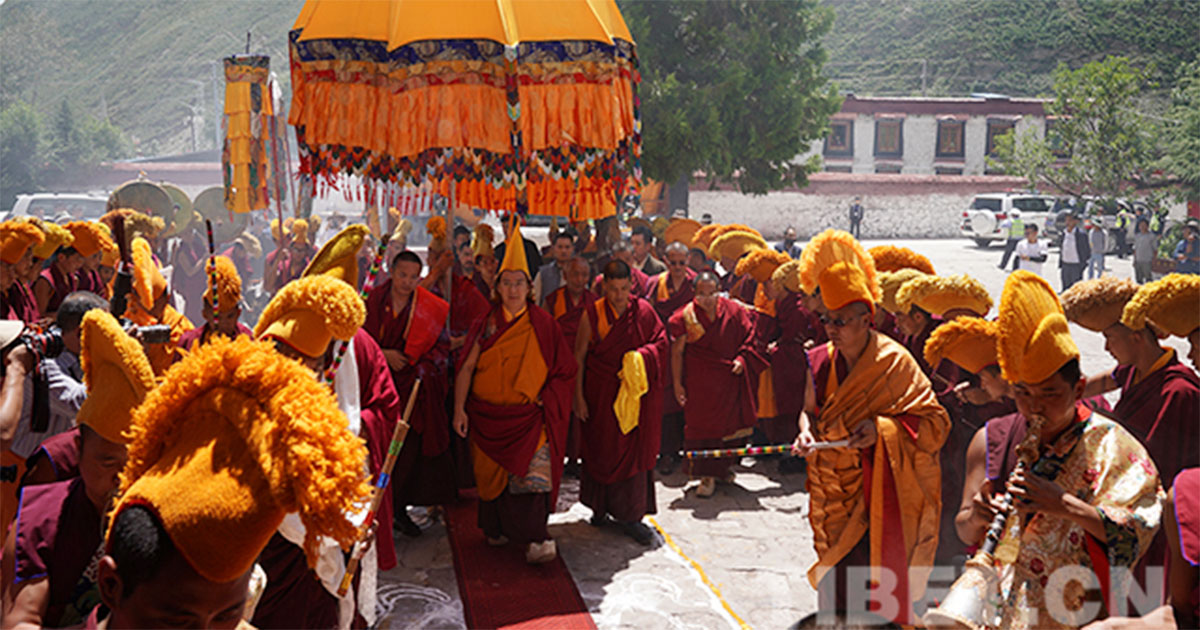
During his visit to Lhokha in the TAR, the Chinese-appointed Panchen Lama conferred a religious ceremony, which the state media said was a “longevity Kalachakra ceremony”.
Wang’s visit to Tibet coincided with a period of greater visibility of the Chinese-appointed Panchen Lama, Gyaltsen (Chinese: Gyalcain) Norbu, including numerous statements in support of the Party and its religious policies. Partly because Norbu had kept a low profile for some months, the flurry of activity was noticeable and seemed to indicate a fresh determination by Chinese authorities to use him as an official and ‘patriotic’ figurehead in the service of the Party.
In the week before Wang’s arrival in Lhasa, the Chinese state media reported that for the first time, Norbu—called “Gya Panchen” (which means “Chinese Panchen”) by Tibetans—visited the sacred lake of Lhamo Latso in Lhokha (Chinese: Shannan) and “prayed for peace, prosperity and stability”.[8] Although the official report did not mention it, the symbolism was not lost on Tibetan Buddhists; Lhamo Latso is frequented by pilgrims aspiring to see visions to aid them, including in the discovery of reincarnations. In 1935, a vision in the lake famously led a search committee to the home of the current Dalai Lama in Amdo, eastern Tibet, followed by his recognition.
This visit is significant in light of the Communist authorities overturning and subverting the traditional process of reincarnation through new regulations to enforce their control over every aspect of the future succession of the Dalai Lama. Norbu’s visit appears to send a message about the Party’s long-term strategy and may also be an attempt to confer legitimacy on Norbu and his association with the process. Some Tibetans who have followed the activities of the Chinese-appointed Panchen Lama clearly recognize this but also believe that the prayers at Lhamo Latso may indicate a sincere effort by Norbu to win recognition among Tibetans in his own right.
Norbu, 27, was installed by Chinese authorities after Gendun Choekyi Nyima, the boy recognized by the Dalai Lama and acknowledged by Tibetans as the authentic Panchen Lama, was ‘disappeared’ in 1995. There is no indication of his whereabouts or welfare more than 20 years later. Panchen Lamas have previously played a role in the recognition and education of Dalai Lamas, and vice versa, which is why management of the Panchen Lama is considered to be so politically crucial by Beijing.
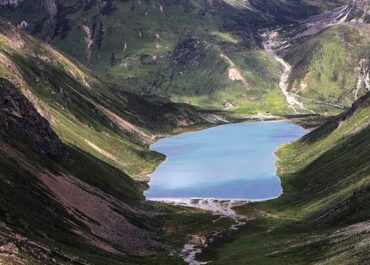
The sacred Lhamo Latso (lake).
The Chinese-appointed Panchen Lama did carry out a Kalachakra initiation in July 2016, used by the authorities as a political showcase and to promote his profile.[10] In exile, the Dalai Lama has presided over this major religious initiation a record number of times.
The August ceremony by Norbu highlights China’s efforts to raise the profile of an individual they appointed to a religious position with political objectives, while seeking to eliminate loyalty to the Dalai Lama, including by preventing Tibetans from traveling to India to attend his teachings.
During his visit to Lhokha, the Chinese-appointed Panchen Lama was cited by official media as asserting the importance of loyalty to China’s leader Xi Jinping and the Party’s religious policies, with the media reporting that “Tibetans must love the Party and the nation, uphold ethnic unity, and promote social harmony and stability. If someone does not contribute to the harmony and stability of the society, he is not qualified to enjoy the fruits of stable development. All the happiness and beauty that Chinese people enjoy today are the results of the efforts of ancestors. In future, people from all backgrounds should jointly contribute to the development and progress of the society, plant good seeds, and make their own efforts for a better future, under the leadership of the Party Central Committee and Party committees and governments at all levels, with Comrade Xi Jinping at its core.”[11]
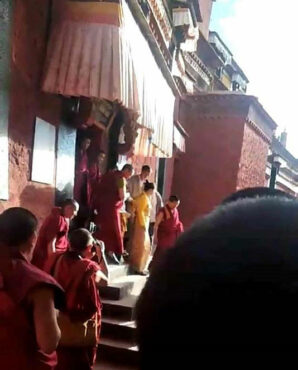
The 10th Panchen Lama’s daughter, Rinzin Wangmo, visits Tashilhunpo monastery in June. (Image: Social media)
While her visit was likely intended to serve the purpose of the Party officials in conveying an image of thriving Buddhist practice in Tibet and ultimately endorsing China’s control over religious practice and its institutions, the emotion of Tibetans in receiving the daughter of a revered leader who sought to protect their religious culture was evident. A former monk from the Tibetan area of Amdo told ICT: “Through the videos and images circulating on social media, we can see how important she is to Tibetans; in particular elderly Tibetans expressed much emotion and devotion, in comparison to their much more circumspect feelings towards the officially-appointed Chinese Panchen Lama.”
Around the same time as the Chinese-appointed Panchen Lama’s visit to Lhamo Latso and following Wang’s trip to Lhasa, the Chinese authorities issued a set of revised disciplinary regulations including a new clause on religion. According to the official press, the revised rules were aimed at “strengthening the core status of Xi Jinping.” The new disciplinary regulations are unambiguous about the penalties for religious belief among Party officials. The state-controlled Global Times stated: “The regulations also introduced a clause that metes out punishment for Party members who follow a religion claiming that Party officials who are religious may distort policies.”[12]
The new ruling follows a drive to recruit Tibetans, particularly young people living in rural areas, to the Chinese Communist Party to ensure loyalty to the state instead of the Dalai Lama. Tibetan schoolchildren in the TAR were prohibited from engaging in traditional devotional practices during the holy Buddhist month of Saga Dawa that fell in May this year.[13]
New monastic database: a strategy to influence a new generation, track monks under suspicion
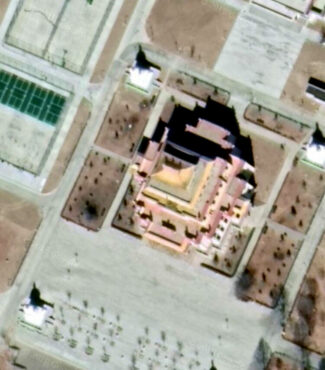
The Tibet Buddhist Theological Institute in Lhasa, which aims to influence a new generation of monks and implement the ‘Sinicization’ of Tibetan Buddhism. This image was captured by satellite in February, 2018, and obtained by ICT.
The stated purpose of the proposed database was to help “share resources” and “jointly compile teaching programs, basic textbooks, and basic tutorial materials.”[14] In reality, the database would advance efforts by the Chinese authorities to consolidate central control and surveillance over every aspect of Tibetan Buddhist religious life and practice.
As with the ‘Neighborhood Committees’ and other elements of ‘grid management’ securitization and total surveillance that are being imposed across Tibet, such a database would allow authorities to gather and store information to be used in a centrally-coordinated system and track monks or nuns who may have returned from India or are under suspicion for their loyalties. Wang Changyu, executive vice president of the Tibetan Buddhism College of China, was cited as saying that the Tibetan institutes needed to emulate the “High-level Tibetan Buddhism College of China [that] has established an initial faculty database, collecting information on masters, teachers, assessing teachers, class managers, debating personnel, researchers, and torampa [sic, Geshe Thorampa, one of the titles instituted in 2004]. This is so that we can share the accumulated knowledge and experience of the masters database and reserve it for the future.’”[15]
The news follows the development in 2016 of an online database of Party-approved Tibetan Buddhist reincarnations, consistent with 2007 measures demonstrating the Party’s agenda to undermine and supplant the Tibetan religious hierarchy and weaken the authority of legitimate Tibetan religious leaders including the Dalai Lama.[16] The new Institutes of Higher Buddhist Studies set up by Party authorities in Lhasa, as well as in Sichuan, Yunnan, Gansu, and Qinghai, are critical to this approach, following the example of the institute in Beijing.
The same official report about the meeting referred to the apparent shortage of teachers and the “weak point” of training teachers. This was likely a reference to continued problems for the Chinese authorities in establishing the loyalty of Tibetan Buddhist lamas and monks to the Communist Party, which they are required to put first above allegiance to spiritual principles. One of the religious leaders present at the meeting, Drupkhang Thubten Khedrup (rendered in Chinese reports as Trukang Thupden Keldro or Zhukang Tubdankezhub), director of the Tibet Buddhist Theological Institute in Lhasa, was cited in the article as saying: “The knowledge structure, level of thinking, and emotional will of a master can greatly influence the physical and mental development of students.”[17]
Khedrup, veteran of the TAR Chinese People’s Political Consultative Conference, has been a prominent critic of the Dalai Lama. At the height of the wave of Tibetan self-immolations in 2012, he accused the Dalai Lama of inciting these actions, which he stated was “despicable”.[18]
The institute in Lhasa headed by Khedrup was opened on Oct. 20, 2011 with investment of around $16 million.[19] Construction had begun in October, 2008, just seven months after a wave of overwhelmingly peaceful protests—led originally by monks from the major monasteries of Lhasa—swept across Tibet. The establishment of this institute and the others outside the TAR were critical to the long-term ambitions of the Party in influencing a new generation of monastics in order to prevent any further dissent.
The institute in Lhasa was expanded last year and is now able to accommodate more than 1,000 students, according to state media reports. Khedrup was cited by official press after the expansion as saying that the institute “aimed to install a love both for China and Buddhism among monks and nuns who study there.”[20]
The predecessor to the institute in Lhasa is the Tibetan Buddhist College in Beijing, which was founded in 1987, with its 30th anniversary coinciding with the imposition of new, more oppressive regulations on religion in 2017.[21] The college was originally founded at the suggestion of the late 10th Panchen Lama, whose searing critique of the Party’s policies against religion was known as the ‘70,000-character petition.’ Although the 10th Panchen Lama’s intentions were to sustain and develop authentic Tibetan Buddhism, the college is now under tight Party control and used simultaneously as a showcase for the religion and as a reminder that religious practice can only be carried out under the auspices of the Party. According to Tibetan sources, a number of Tibetan monks and lamas who attended the school have disrobed in recent years.
At the same time, Chinese authorities have imposed a new ruling in some areas of eastern Tibet that highly educated Tibetan monks who studied in India are being banned from teaching Buddhism when they return to Tibet. While reports on this specifically referred to Lithang, Tibetan sources have confirmed that the Chinese authorities have been imposing the same restrictions elsewhere, including at the important and influential monastery of Labrang Tashikyil in the Tibetan area of Amdo, in present-day Gansu Province. Monks who studied in India have long been unable to teach in monasteries in the TAR, including in the three main religious institutions of Sera, Drepung, and Ganden.[22]
Footnotes:
[1] Global Times, ‘Top official asks Tibetan Buddhists to firmly uphold leadership of CPC’ by Xu Hailin, August 27, 2018.
[2] Xinhua, ‘Top political advisor stresses poverty relief, religious work in Tibet’, August 26, 2018, http://www.xinhuanet.com/english/2018-08/26/c_137420747.htm
[4] See International Campaign for Tibet report, ‘China’s revised religious regulations threaten survival of Tibetan Buddhism’, September 17, 2017, https://www.https://savetibet.org/chinas-revised-religious-regulations-threaten-survival-of-tibetan-buddhism/
[5] Xinhua, July 29, 2018, http://www.xinhuanet.com/english/2018-07/29/c_137354330.htm
[6] ChinaTibetNews portal in Chinese, August 23, 2018, http://epaper.chinatibetnews.com/xzrb/html/2018-08/23/content_849561.htm
[7] See International Campaign for Tibet report, ‘Access Denied: China’s enforced isolation of Tibet and the case for reciprocity’, May 7, 2018, https://www.https://savetibet.org/access-denied-chinas-enforced-isolation-of-tibet-and-the-case-for-reciprocity/cover-1-web/
[8] Xinhua, August, 20, 2018, http://eng.tibet.cn/eng/news/tibetan/201808/t20180820_6189684.html
[9] Xinhua, August 28, 2018, http://eng.tibet.cn/eng/news/tibetan/201808/t20180828_6212968.html
[10] International Campaign for Tibet report, ‘Kalachakra with Chinese characteristics: Chinese appointed Panchen Lama gives teaching as authorities suppress religious freedom’, July 29, 2016, https://www.https://savetibet.org/kalachakra-with-chinese-characteristics-chinese-appointed-panchen-lama-gives-teaching-as-authorities-suppress-religious-freedom/ It is important to note that the Kalachakra ceremony in the TAR on July 21-24, 2016, was not the first to be held in Tibet since the Dalai Lama fled into exile. While repressive measures on religious practice have intensified, some major religious ceremonies including Kalachakra rituals have been permitted in Tibetan areas outside the Tibet Autonomous Region in recent years, attracting hundreds of thousands of Tibetans.
[11] Xinhua, August 20, 2018, http://eng.tibet.cn/eng/index/rolling/201808/t20180820_6189505.html
[12] Global Times, ‘CPC metes out severe punishment for disloyalty, corruption in revised regulation’, by Zhang Hui, August 27, 2018.
[13] International Campaign for Tibet report, ‘Monks who studied in India banned from teaching in Tibet; new ruling bans schoolchildren from religious activity’, May 17, 2018, https://www.https://savetibet.org/monks-who-studied-in-india-banned-from-teaching-in-tibet-new-ruling-bans-schoolchildren-from-religious-activity
[14] China’s Tibetan Buddhist institutions advocate for “shared master database”, China Tibet Online, July 16, 2018.
[16] International Campaign for Tibet report, ‘The “poisonous fruit” of Tibet’s religious policy as China publishes ‘Living Buddha’ database’, May 2, 2016, https://www.https://savetibet.org/the-poisonous-fruit-of-tibets-religious-policy-as-china-publishes-living-buddha-database/
[17] ‘China’s Tibetan Buddhist institutions advocate for “shared master database”’, China Tibet Online, July 16, 2018.
[18] Chinese state media report, ‘Zhukang Tudengkezhu Living Buddha: Self-immolation destroys religious conscience’, People’s Network, March 29, 2012, http://politics.people.com.cn/GB/17529529.html
[19] Xinhua, October 20, 2008.
[20] Buddhist Door, ‘Expansion Project Complete at the Tibet Buddhist Theological Institute in Lhasa’, September 13, 2017, www.buddhistdoor.net
https://www.buddhistdoor.net/news/expansion-project-complete-at-the-tibet-buddhist-theological-institute-in-lhasa
[21] International Campaign for Tibet, ‘China’s revised religious regulations threaten the survival of Tibetan Buddhism’, September 18, 2017, https://www.https://savetibet.org/chinas-revised-religious-regulations-threaten-survival-of-tibetan-buddhism/
[22] International Campaign for Tibet report, ‘Monks who studied in India banned from teaching in Tibet; new ruling bans schoolchildren from religious activity’, May 17, 2018, https://www.https://savetibet.org/monks-who-studied-in-india-banned-from-teaching-in-tibet-new-ruling-bans-schoolchildren-from-religious-activity

